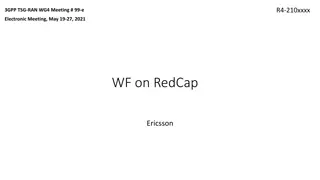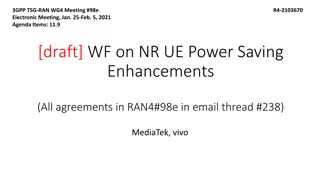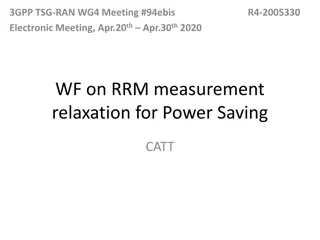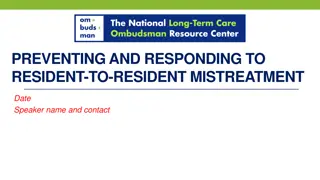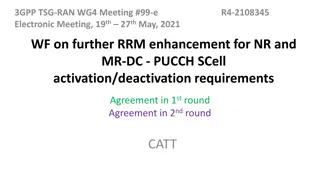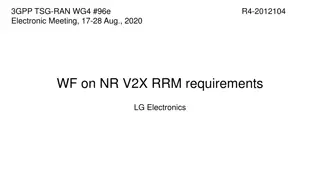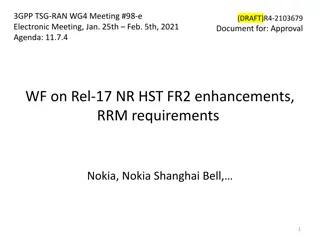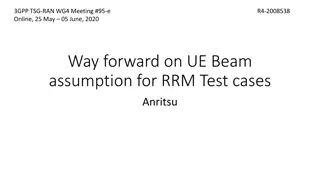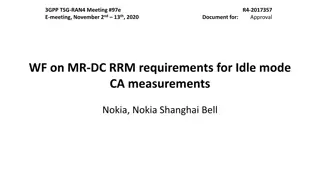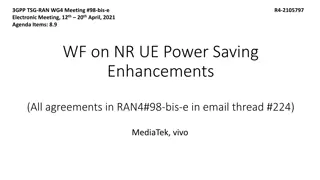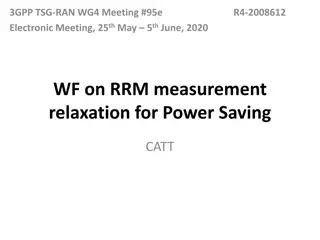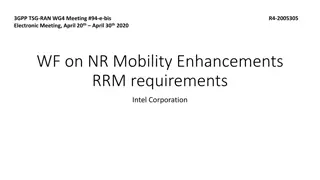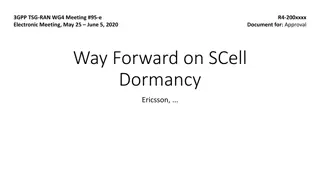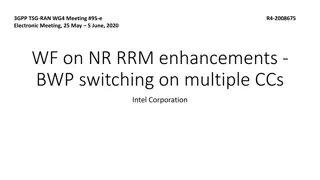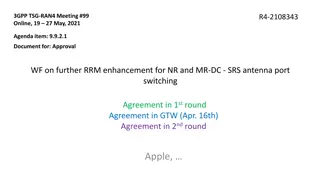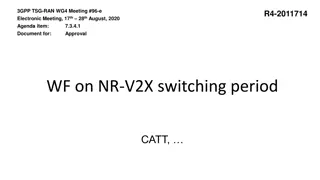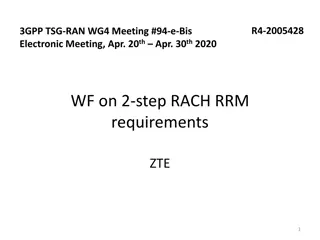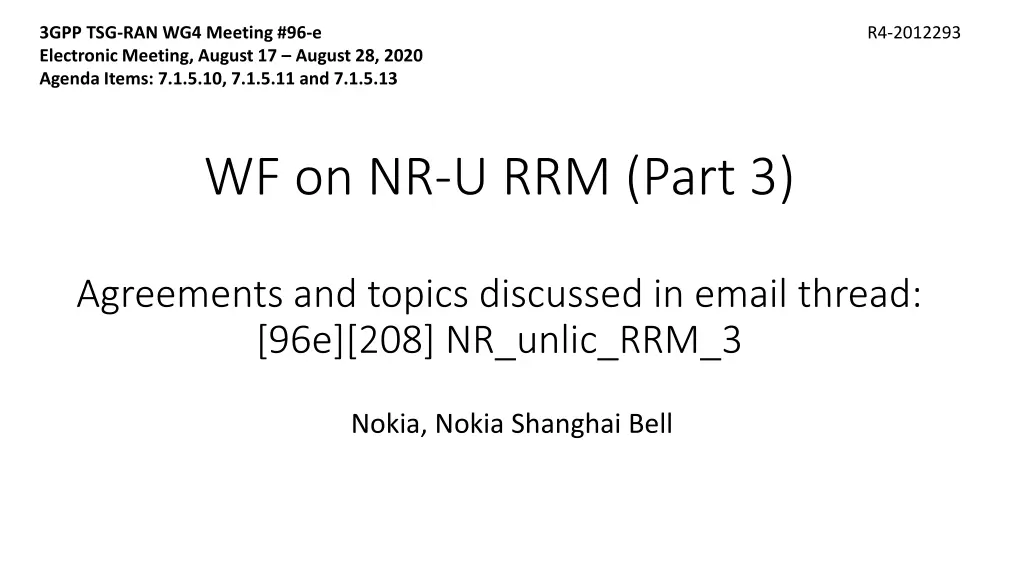
3GPP TSG-RAN-WG4 Meeting #96-e August 2020 Agenda Items and Topics Discussed
Explore the agreements and topics discussed in the electronic meeting of 3GPP TSG-RAN-WG4 Meeting #96-e held in August 2020. Delve into issues surrounding intra and inter-frequency measurements, monitoring of QCL beams, UE behavior in RRC_CONNECTED mode, and more related to NR-U RRM.
Download Presentation

Please find below an Image/Link to download the presentation.
The content on the website is provided AS IS for your information and personal use only. It may not be sold, licensed, or shared on other websites without obtaining consent from the author. If you encounter any issues during the download, it is possible that the publisher has removed the file from their server.
You are allowed to download the files provided on this website for personal or commercial use, subject to the condition that they are used lawfully. All files are the property of their respective owners.
The content on the website is provided AS IS for your information and personal use only. It may not be sold, licensed, or shared on other websites without obtaining consent from the author.
E N D
Presentation Transcript
3GPP TSG-RAN WG4 Meeting #96-e Electronic Meeting, August 17 August 28, 2020 Agenda Items: 7.1.5.10, 7.1.5.11 and 7.1.5.13 R4-2012293 WF on NR-U RRM (Part 3) Agreements and topics discussed in email thread: [96e][208] NR_unlic_RRM_3 Nokia, Nokia Shanghai Bell
Agreements in the 1st round Agreements in the GTW session Agreements in the 2nd round Still open for discussion
Topic #1: Remaining issues in intra and inter Topic #1: Remaining issues in intra and inter- - frequency measurements frequency measurements Issue 1-1-1: Monitoring of QCL beams during cell detection in NR-U RRM core requirements are defined under assumption what UE monitors the first 2 successive QCL ed candidate SSB positions (i.e. N1 = N2 = 2) FFS if same values apply for cell detection Option 1: For cell detection the requirements are defined under assumption that UE monitors at least 1 candidate SSB position in one SSB block burst Option 2: Same value applies as for other RRM measurements The total number of candidate SSBs indexes and number of cell UE shall monitor remains unchanged
Topic #1: Remaining issues in intra and inter Topic #1: Remaining issues in intra and inter- - frequency measurements frequency measurements Issue 1-1-2: Monitoring of QCL beams during measurements in NR-U In NR-U work, RAN4 assumes that no explicit or signalled UE capabilities will be defined for the number of candidate SS/PBCH block indexes corresponding to the same SS/PBCH block index the UE should monitor in a given discovery burst transmission window (for RRM) or within the set of configured resources (for RLM/CBD/BFD). Agreements No differentiation between UE in FBE and LBE modes in NR-U RRM Core requirements. Different test case will be defined for UE in FBE and LBE modes in NR-U RRM Performance requirements. Agreements RRM core requirements are defined under assumption what UE monitors the first 2 successive QCL ed candidate SSB positions (i.e. N1 = N2 = 2) o The total number of candidate SSBs indexes and number of cell UE shall monitor remains unchanged
Topic #1: Remaining issues in intra and inter Topic #1: Remaining issues in intra and inter- - frequency measurements frequency measurements Issue 1-2-1: UE behavior in RRC_CONNECTED mode when serving cell is unavailable for consecutive SSB bursts Do not specify additional UE behavior in RRC_CONNECTED mode when serving cell is unavailable for consecutive SSB bursts
Topic #1: Remaining issues in intra and inter Topic #1: Remaining issues in intra and inter- - frequency measurements frequency measurements Issue 1-3-1: UE behaviour in case of successively exceeding the maximum number of DL LBT failure during measurements After N unsuccessful measurement attempts of an already identified cell due to exceeding max number of unavailable SMTC occasions, the UE shall stop the measurement attempts on this SSB and perform the detection procedure again like for any other SSB
Topic #1: Remaining issues in intra and inter Topic #1: Remaining issues in intra and inter- - frequency measurements frequency measurements Issue 1-4-1: Applicability of SMTC2 signaling to NR-U Signaling of smtc2 is applicable to unlicensed band.
Topic #1: Remaining issues in intra and inter Topic #1: Remaining issues in intra and inter- - frequency measurements frequency measurements Issue 1-4-2: Scheduling restriction during SS-RSRP, SS-RSRQ and SS-SINR when deriveSSB_IndexFromCell is not enabled. If deriveSSB_IndexFromCell is not enabled the UE is not expected to transmit PUCCH/PUSCH/SRS on all symbols within DRS window duration
Topic #1: Remaining issues in intra and inter Topic #1: Remaining issues in intra and inter- - frequency measurements frequency measurements Issue 1-4-3: Definition of scheduling restrictions during SS-RSRP and SS-SINR measurements When the UE performs intra-frequency measurements in unlicensed spectrum, the following restrictions apply due to SS-RSRP or SS-SINR measurement - The UE is not expected to transmit PUCCH/PUSCH/SRS on SSB symbols configured to be measured, and on 1 data symbol before each consecutive SSB symbols configured to be measured and 1 data symbol after each consecutive SSB symbols configured to be measured within SMTC window duration if deriveSSB_IndexFromCell is enabled. If the high layer in TS 38.331 signaling of smtc2 is configured, the SMTC periodicity follows smtc2; Otherwise SMTC periodicity follows smtc1. - The UE is not expected to transmit PUCCH/PUSCH/SRS on all symbols within SMTC window duration if deriveSSB_IndexFromCell is not enabled. If the high layer in TS 38.331 signaling of smtc2 is configured, the SMTC periodicity follows smtc2; Otherwise SMTC periodicity follows smtc1. When intra-band carrier aggregation in unlicensed spectrum is performed, the scheduling restrictions due to a given serving cell should also apply to all other serving cells in the same band on the symbols that fully or partially overlap with the aforementioned restricted symbols.
Topic #1: Remaining issues in intra and inter Topic #1: Remaining issues in intra and inter- - frequency measurements frequency measurements Issue 1-4-4: Definition of scheduling restrictions during SS-RSRQ measurements o When the UE performs intra-frequency measurements in unlicensed spectrum, the following restrictions apply due to SS-RSRQ measurement - The UE is not expected to transmit PUCCH/PUSCH/SRS on SSB symbols configured to be measured, RSSI measurement symbols, and on 1 data symbol before each consecutive SSB configured to be measured/RSSI symbols and 1 data symbol after each consecutive SSB configured to be measured/RSSI symbols within SMTC window duration if deriveSSB_IndexFromCell is enabled. If the high layer signaling of smtc2 is configured(in TS 38.331), the SMTC periodicity follows smtc2; Otherwise the SMTC periodicity follows smtc1. - The UE is not expected to transmit PUCCH/PUSCH/SRS on all symbols within SMTC window duration if deriveSSB_IndexFromCell is not enabled. If the high layer in TS 38.331 signaling of smtc2 is configured, the SMTC periodicity follows smtc2; Otherwise SMTC periodicity follows smtc1. o When intra-band carrier aggregation in unlicensed spectrum is performed, the scheduling restrictions due to a given serving cell should also apply to all other serving cells in the same band on the symbols that fully or partially overlap with the aforementioned restricted symbols
Topic #1: Remaining issues in intra and inter Topic #1: Remaining issues in intra and inter- - frequency measurements frequency measurements Issue 1-4-5: Scheduling restrictions in inter-band CA FFS: In FR1 inter-band CA, the scheduling restriction due to one CC shall not apply to other CCs on the other bands.
Topic #1: Remaining issues in intra and inter Topic #1: Remaining issues in intra and inter- - frequency measurements frequency measurements Issue 1-5-1: UE behavior when receiving the MAC CE deactivation command for semi-persistent CSI reporting, in case of UL LBT failure for sending the ACK o Option 1: At least from MAC (RAN2) layer perspective, UE follows the actions related to MAC-CE activation/deactivation command immediately after decoding the MAC-CE command regardless of whether UE is able to send HARQ-ACK feedback or not. o Option 2 :If UE cannot transmit HARQ-ACK on MAC-CE deactivation due to UL CCA failure, UE continues to be in its previous state, i.e., it should measure and report L1-RSRP until it successfully transmits HARQ-ACK.
Topic #1: Remaining issues in intra and inter Topic #1: Remaining issues in intra and inter- - frequency measurements frequency measurements Issue 1-6-1: Measurement capability Same as licensed MO merging requirement on same NR carrier frequency layer, the principle to merge MOs on same NR-U carrier frequency layer is that those MOs would not need different measurement efforts from UE. o Proposal 2: UE won t merge NR-U MOs on the same frequency layer from PCell and PSCell if any of the following conditions is met, - different RSSI measurement resources or - different deriveSSB-IndexFromCell indications or - different SMTC configurations or, - different ssb-PositionQCL-Common-r16 indications or cell list of ssb- PositionQCL or, - different rmtc-Config-r16 indication.
Topic #2: RSSI and CO measurements Topic #2: RSSI and CO measurements Issue 2-1-1: Intra-frequency RSSI measurement definition No additional condition is needed for the intra-frequency measurement definition
Topic #2: RSSI and CO measurements Topic #2: RSSI and CO measurements Issue 2-1-2: Need for measurement gaps in RSSI measurements Measurement gaps are needed for RSSI/CO measurements when RSSI BW is not fully within the active DL BWP of the UE.
Topic #2: RSSI and CO measurements Topic #2: RSSI and CO measurements Issue 2-2-1: RSSI measurement BW Candidate options: o Option 1 (Ericsson, Apple, Intel and Nokia): RSSI measurement bandwidth is the LBT bandwidth o Option 2 (MediaTek, Qualcomm): The discussion can take place in the performance work
Topic #2: RSSI and CO measurements Topic #2: RSSI and CO measurements Issue 2-3-1: RSSI measurement period when measurement gaps are not required SMTC and RMTC are overlapping The RSSI and CO measurement periods depend on: max(reportInterval, rmtc-Period*CSSFoutside_gap,i) in non-DRX when measurement gaps are not required, max(reportInterval, max(rmtc-Period, DRX)*CSSFoutside_gap,i) in DRX when measurement gaps are not required, CSSFoutside_gap,itakes into account the overlap between SMTC and RMTC SMTC and RMTC are not overlapping RSSI/CO measurement period is scaled with Nintra-MO, and corresponds to: max(reportInterval, rmtc-Period* Nintra-MO) when DRX is not used max(reportInterval, Nintra-Mo*max( rmtc-Period, DRXcycle length))when DRX is used where Nintra-MO , reportInterval, and rmtc-Period is defined as the number of measurement objects that can be measured without gaps, configured reporting interval, and configured RMTC period, respectively.
Topic #2: RSSI and CO measurements Topic #2: RSSI and CO measurements Issue 2-3-2: RSSI measurement period when measurement gaps are required When measurement gap is required, RSSI/CO measurement period corresponds to: max(reportInterval, max(rmtc-Period, MGRP)* CSSFwithin_gap,i) when DRX is not used max(reportInterval, max(rmtc-Period, MGRP, DRXcycle length )* CSSFwithin_gap,i) when DRX is used where CSSFwithin-gap,i is determined in clause 9.1.5.2 for measurement conducted within measurement gaps."
Topic #2: RSSI and CO measurements Topic #2: RSSI and CO measurements Issue 2-3-3: Scaling factor for DRX 320ms Agreement: For RSSI Measurements, do not use the scaling factor of 1.5 when DRX 320ms.
Topic #2: RSSI and CO measurements Topic #2: RSSI and CO measurements Issue 2-3-4: CSSF definition outside measurement gaps CSSF outside measurement gaps needs also to be adapted to account for RSSI/CO measurements.
Topic #2: RSSI and CO measurements Topic #2: RSSI and CO measurements Issue 2-4-1: RAN4 to define scheduling restrictions during RSSI/CO measurements RAN 4 to define scheduling restrictions during RSSI/CO measurements
Topic #2: RSSI and CO measurements Topic #2: RSSI and CO measurements Issue 2-4-2: Differentiate the scheduling restriction during RSSI measurements when deriveSSB_indexFromCell is enabled or not For scheduling restrictions during RSSI/CO measurements, do not differentiate the cases in which deriveSSB_indexFromCell is enabled or not
Topic #2: RSSI and CO measurements Topic #2: RSSI and CO measurements Issue 2-4-3: Exact definition of scheduling restriction during RSSI/CO measurements When the UE performs intra-frequency RSSI/CO measurements in unlicensed spectrum, the following restrictions apply due to RSSI/CO measurements The UE is not expected to transmit PUCCH/PUSCH/SRS on RSSI measurement symbols configured by RMTC. When intra-band carrier aggregation in unlicensed spectrum is performed, the scheduling restrictions due to a given serving cell should also apply to all other serving cells in the same band on the symbols that fully or partially overlap with the aforementioned restricted symbols. FFS: whether it is necessary to include the restriction on 1 data symbol before the first RSSI measurement symbol configured by RMTC, and 1 data symbol after the last RSSI measurement symbol configured by RMTC
Topic #2: RSSI and CO measurements Topic #2: RSSI and CO measurements Issue 2-4-4: Define scheduling restriction during RSSI measurements when the configured SCS in RMTC is different from the data SCS Do not define scheduling restriction when the RMTC window duration if the SCS configured in RMTC is different from the SCS of data.

